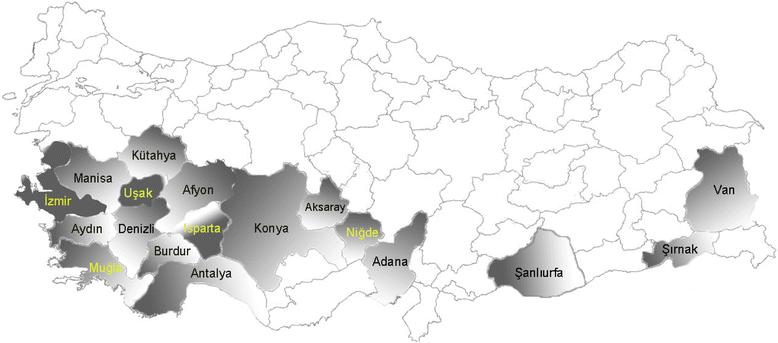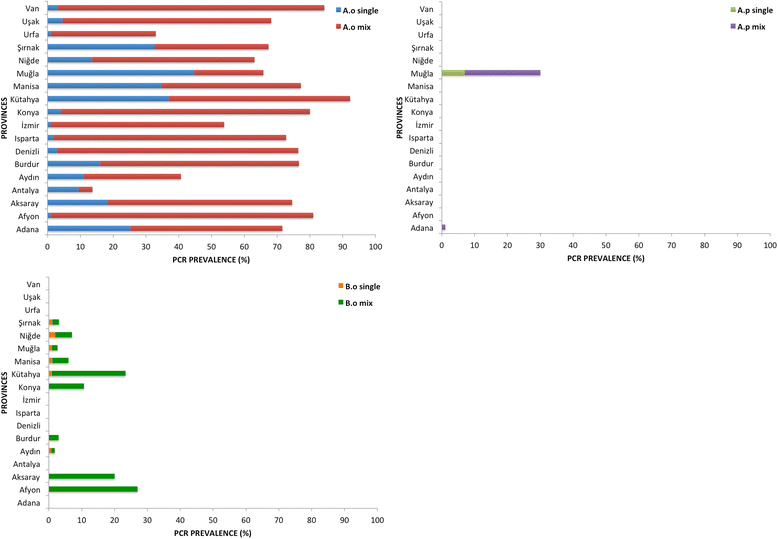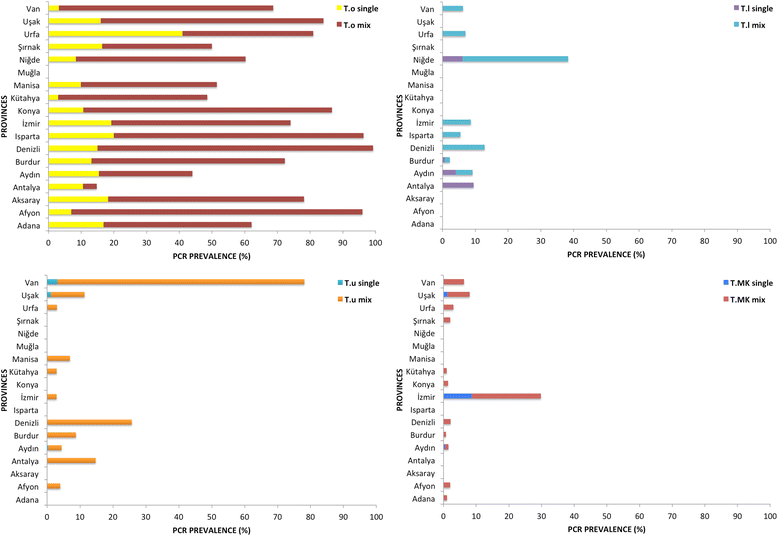Prevalence of tick-borne haemoparasites in small ruminants in Turkey and diagnostic sensitivity of single-PCR and RLB
- PMID: 28449722
- PMCID: PMC5408456
- DOI: 10.1186/s13071-017-2151-3
Prevalence of tick-borne haemoparasites in small ruminants in Turkey and diagnostic sensitivity of single-PCR and RLB
Abstract
Background: Tick-borne haemoparasitic diseases (TBHDs), caused by Theileria, Babesia, Anaplasma and Ehrlichia, are common in regions of the world where the distributions of host, pathogen and vector overlap. Many of these diseases threaten livestock production and some also represent a concern to human public health. The primary aim of this study was to determine the prevalence of the above-mentioned pathogens in a large number of blood samples (n = 1979) collected from sheep (n = 1727) and goats (n = 252) in Turkey. A secondary aim was to assess the diagnostic sensitivity of a number of species-specific polymerase chain reaction (PCR) tests and the reverse line blotting (RLB) assay. DNA samples were screened using species-specific PCR for the presence of Theileria ovis, Theileria sp. MK, T. lestoquardi, T. uilenbergi, T. luwenshuni, Babesia ovis, Anaplasma ovis and A. phagocytophilum while RLB was undertaken to test for the presence of all known Theileria, Babesia, Anaplasma and Ehrlichia species. The diagnostic sensitivity of these two approaches was then compared in terms of their ability to detect single species and mixed infections.
Results: Overall, 84 and 74.43% of the small ruminants sampled were identified as hosting one or more pathogen(s) by species-specific PCR and RLB respectively. The presence of Theileria sp. OT1, T. luwenshuni and T. uilenbergi in Turkey was revealed for the first time while the presence of Babesia motasi, B. crassa and T. separata in Turkish small ruminants was confirmed using molecular methods. A high prevalence of mixed infection was evident, with PCR and RLB approaches indicating that 52.24 and 35.42% of animals were co-infected with multiple species, respectively. More than 80% of the mixed infections contained T. ovis and/or A. ovis. The RLB approach was found to be capable of detecting mixed infections with species such as Theileria sp. OT1, Theileria sp. OT3, T. separata, B. crassa and Babesia spp.
Conclusion: The results indicated that pathogens causing TBHDs are highly prevalent in sheep and goats in Turkey. The diagnostic sensitivity of species-specific single PCR was generally higher than that of RLB. However, the latter approach was still capable of identifying a high proportion of individuals containing mixed-species infections. The use of species-specific single PCR is recommended to accurately estimate pathogen prevalence and to identify co-infected hosts.
Keywords: Goat; Prevalence; RLB; Sheep; Species-specific PCR; Tick-borne pathogens; Turkey.
Figures



References
-
- Ahmed JS, Luo JX, Scnittger L, Seitzer U, Jongejan F, Yin H. Phylogenetic position of small-ruminant infecting piroplasms. In: Blouin EF, Maillard JC, editors. Impact of emerging zoonotic diseases on animal health. 2006. pp. 498–504. - PubMed
Publication types
MeSH terms
LinkOut - more resources
Full Text Sources
Other Literature Sources
Medical
Molecular Biology Databases
Miscellaneous

